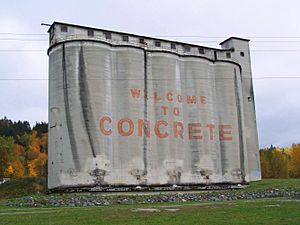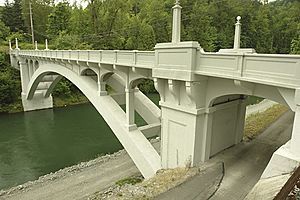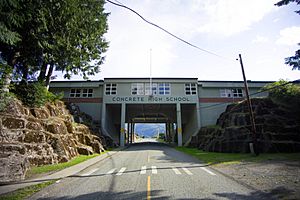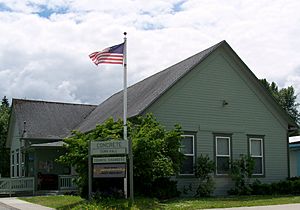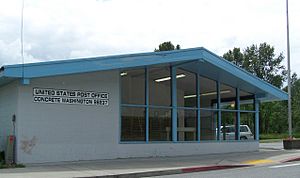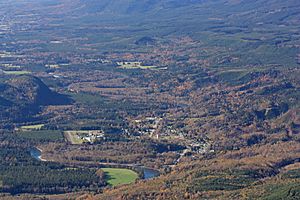Concrete, Washington facts for kids
Quick facts for kids
Concrete
|
||
|---|---|---|
| Concrete, Washington | ||
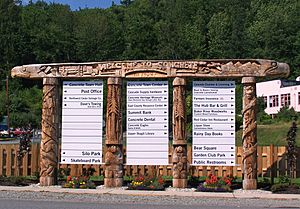
Concrete's town welcome sign, which was chainsaw-carved from cedar logs
|
||
|
||

Location of Concrete, Washington
|
||
| Country | United States | |
| State | Washington | |
| County | Skagit | |
| Area | ||
| • Total | 1.21 sq mi (3.13 km2) | |
| • Land | 1.17 sq mi (3.04 km2) | |
| • Water | 0.04 sq mi (0.09 km2) | |
| Elevation | 276 ft (84 m) | |
| Population
(2020)
|
||
| • Total | 801 | |
| • Density | 662.0/sq mi (255.9/km2) | |
| Time zone | UTC−8 (Pacific (PST)) | |
| • Summer (DST) | UTC−7 (PDT) | |
| ZIP code |
98237
|
|
| Area code(s) | 360 | |
| FIPS code | 53-14380 | |
| GNIS feature ID | 1518004 | |
| Website | Town of Concrete | |
Concrete is a small town located in the northern part of Skagit County, Washington, United States. It is part of a larger metropolitan area that includes Mount Vernon and Anacortes. In 2020, about 801 people lived in Concrete.
Contents
Early History of Concrete Town
The town of Concrete has had a few different names over the years. It first started as a settlement called "Minnehaha" where the Baker and Skagit Rivers meet. One of the first people to settle there was Amasa "Peg-Leg" Everett. In 1890, another settler, Magnus Miller, planned out the town.
Soon after, a post office opened, and the town's name changed to "Baker." In 1905, a new settlement grew across the Baker River. This happened because the Washington Portland Cement Company was built there. This new area was called "Cement City."
In 1908, the Superior Portland Cement Company built a plant in Baker. People decided to combine the two towns, Baker and Cement City. The people living in the new, bigger community chose the name "Concrete." The town officially became "Concrete" on May 8, 1909.
Important Buildings and Landmarks
Concrete is home to several old and important buildings. It also has some impressive engineering achievements.
Henry Thompson Bridge: A Historic Arch
The Henry Thompson Bridge was built between 1916 and 1918. It was named after Henry Thompson, a local settler and county leader. He worked hard to get the bridge built. Sadly, he died in a logging train accident in 1918.
When it was built, this bridge had the longest single arch made of reinforced concrete in the world, or at least in the western United States. It has been listed on the Washington State and National Historic Register since 1976. Until 1972, this bridge was the only way to cross the Baker River and reach eastern Skagit County.
The bridge was designed by Bowerman and McCloy Consulting Engineers. It was built by J.R. Wood Contractors, both from Seattle. The bridge was fully repaired between 2003 and 2004.
Concrete High School: A Unique Design
Concrete High School was built in 1952. It has all the usual parts of a school. But it also has one very unusual feature: the middle part of the building was built right over the road! South Superior Avenue actually passes underneath the school. This design helped make the best use of the land.
This building replaced an older high school in the town center. The hallways and wood shop of the school were used in the movie This Boy's Life in 1993. Concrete High School's colors are purple and gold, and their team mascot is the Lion. Their sports teams play in the Northwest 1B/2B league.
Concrete Herald Building: A Local Newspaper's Home
The Concrete Herald Building is located on Main Street in the center of Concrete. It was first built in 1918 as a garage for Model T Ford cars. It even had a gas station out front. Later, it became a logging facility, and a large apartment was added upstairs.
After that, Charles M. "Chuck" Dwelley, the owner and editor of Concrete Herald, bought the building. He turned it into a modern printing facility and the new home for the newspaper, which started in 1910. The newspaper was sold in 1990 and the building became a printing shop.
Today, the first floor of the building is a liquor store. The Concrete Herald newspaper has been brought back by Concrete Mayor Jason Miller. Since May 6, 2009, the newspaper is published monthly. You can find it in different places throughout Skagit County.
Concrete Town Hall: From School to Government
Concrete's Town Hall was first built in 1908 as a grade school. It was made of wood with overlapping boards. It was originally on Main Street, across from the bank. Classes were taught there until 1910.
When it was no longer used as a school, the building was moved to its current spot on West Main Street. It is next to the post office. In its new location, the building has been used as a library and a senior-citizen center. Today, it serves as the town hall. It also has a small office for the Skagit County Sheriff's Department.
Concrete Theatre: Entertainment Through the Years
The Concrete Theatre was built in 1923. Its stage has hosted many different types of shows. These include vaudeville acts, boxing matches, and silent films. Later, it showed "talkies," which were movies with sound. The building is listed on the Washington Heritage Register.
Over the years, the theater changed owners many times. But it always kept its original design as a single-screen movie theater. In 2009, new owners bought it and fixed it up. Now, it can seat 130 people and has a full stage and dance floor. The refurbished balcony seats 8 people. In 2012, the community helped raise money to buy a digital projector. This helped keep the theater open.
In 2021, the Concrete Theatre grew even bigger. They bought the building next door, which was originally the Monrad Grocery built in 1915. This new space now has an ice cream parlor, the theater's box office, and an extra room for meetings or screenings.
Lower Baker Dam: A Record-Breaking Structure
The Lower Baker Dam was finished in 1925. Two years later, it was made even taller, reaching 293 feet (89 meters). At that time, it was the highest hydroelectric dam in the world. A hydroelectric dam uses water to create electricity. Today, Puget Sound Energy owns and operates this dam.
Famous Author Connection
The famous author Tobias Wolff spent a lot of his teenage years in the Concrete area. Wolff's book, This Boy's Life, tells the story of his early life. It describes living in eastern Skagit County and going to Concrete High School. In the book, the school is called "Chinook High School."
In 1993, the book was made into a movie. It starred famous actors like Leonardo DiCaprio, Robert De Niro, and Ellen Barkin. Many outdoor scenes for the movie, and some indoor ones, were filmed in Concrete and the surrounding area. Many local people even got to be extras in the film. To make the town look like it did in the 1950s, Concrete was changed to fit the "Hollywood style" for the weeks of filming in 1992.
Geography of Concrete
According to the United States Census Bureau, the town of Concrete covers about 1.24 square miles (3.21 square kilometers). Most of this area is land, with a small part being water.
The town is mostly on the north side of the Skagit River. It is also divided by the lower Baker River, which flows into the Skagit River. Two large mountains, Mount Baker and Mount Shuksan, are located near Concrete. Both of these peaks are part of the North Cascades mountain range.
Climate in Concrete
Concrete has a warm summer Mediterranean climate. This means it has cool winters and warm, mostly dry summers. Most of the rain in Concrete falls as rain, but sometimes it snows. About 20 inches (50 cm) of snow falls each year.
| Climate data for Concrete, Washington | |||||||||||||
|---|---|---|---|---|---|---|---|---|---|---|---|---|---|
| Month | Jan | Feb | Mar | Apr | May | Jun | Jul | Aug | Sep | Oct | Nov | Dec | Year |
| Record high °F (°C) | 65 (18) |
74 (23) |
82 (28) |
93 (34) |
96 (36) |
106 (41) |
102 (39) |
102 (39) |
102 (39) |
87 (31) |
77 (25) |
63 (17) |
106 (41) |
| Mean daily maximum °F (°C) | 41.7 (5.4) |
47.3 (8.5) |
53.1 (11.7) |
60.3 (15.7) |
66.9 (19.4) |
71.0 (21.7) |
76.8 (24.9) |
76.9 (24.9) |
71.0 (21.7) |
60.8 (16.0) |
49.0 (9.4) |
42.9 (6.1) |
59.8 (15.4) |
| Daily mean °F (°C) | 36.4 (2.4) |
40.0 (4.4) |
44.2 (6.8) |
49.8 (9.9) |
55.8 (13.2) |
60.2 (15.7) |
64.5 (18.1) |
64.7 (18.2) |
60.0 (15.6) |
52.0 (11.1) |
43.0 (6.1) |
38.0 (3.3) |
50.7 (10.4) |
| Mean daily minimum °F (°C) | 31.1 (−0.5) |
32.8 (0.4) |
35.2 (1.8) |
39.3 (4.1) |
44.7 (7.1) |
49.4 (9.7) |
52.2 (11.2) |
52.5 (11.4) |
49.0 (9.4) |
43.3 (6.3) |
37.1 (2.8) |
33.1 (0.6) |
41.6 (5.4) |
| Record low °F (°C) | −1 (−18) |
1 (−17) |
11 (−12) |
25 (−4) |
29 (−2) |
35 (2) |
38 (3) |
31 (−1) |
30 (−1) |
10 (−12) |
7 (−14) |
0 (−18) |
−1 (−18) |
| Average precipitation inches (mm) | 9.5 (240) |
6.8 (170) |
6.7 (170) |
4.4 (110) |
3.3 (84) |
2.7 (69) |
1.4 (36) |
1.7 (43) |
3.5 (89) |
6.8 (170) |
10.5 (270) |
10.3 (260) |
67.6 (1,711) |
| Average snowfall inches (cm) | 6.0 (15) |
4.4 (11) |
1.3 (3.3) |
0.1 (0.25) |
0 (0) |
0 (0) |
0 (0) |
0 (0) |
0 (0) |
0 (0) |
1.6 (4.1) |
6.5 (17) |
19.9 (50.65) |
Population Information
| Historical population | |||
|---|---|---|---|
| Census | Pop. | %± | |
| 1910 | 945 | — | |
| 1920 | 924 | −2.2% | |
| 1930 | 736 | −20.3% | |
| 1940 | 859 | 16.7% | |
| 1950 | 760 | −11.5% | |
| 1960 | 840 | 10.5% | |
| 1970 | 573 | −31.8% | |
| 1980 | 592 | 3.3% | |
| 1990 | 735 | 24.2% | |
| 2000 | 790 | 7.5% | |
| 2010 | 705 | −10.8% | |
| 2020 | 801 | 13.6% | |
| U.S. Decennial Census | |||
2010 Census Details
In 2010, the town of Concrete had 705 people living there. There were 295 households, and 179 of these were families. The town had about 578 people per square mile.
Most of the people living in Concrete were White (91.5%). A small number were Native American (2.0%), Asian (0.4%), or African American (0.3%). About 5.5% of the population was Hispanic or Latino.
About 31.5% of households had children under 18. About 42% were married couples. The average household had 2.39 people, and the average family had 2.93 people. The average age in Concrete was 40.4 years old. About 26.2% of residents were under 18, and 12.1% were 65 or older.
Transportation in Concrete
Mears Field (3W5), also known as Concrete Municipal Airport, is located one mile south of Concrete. It is 267 feet (81 meters) above sea level.
See also
 In Spanish: Concrete (Washington) para niños
In Spanish: Concrete (Washington) para niños



